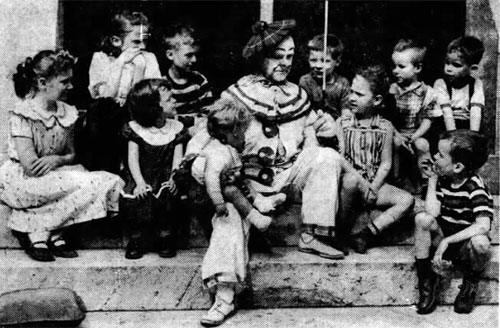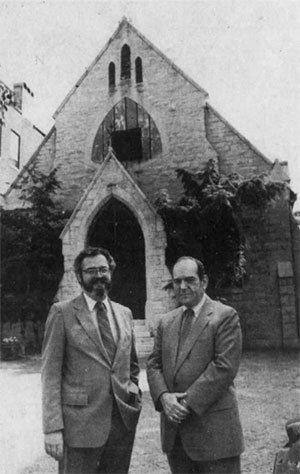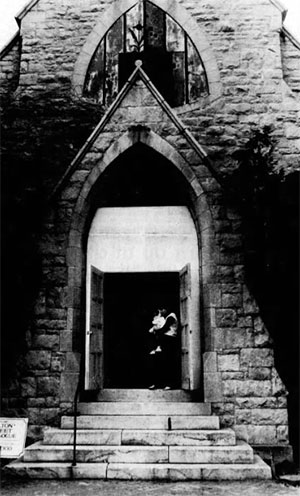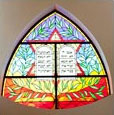The edifice at what is currently 1311 Bolton Street was built in 1876 as a Reformed Episcopal church called the Church of the Redeemer. Over the years it was also an Associate Congregational Church, a shelter for servicemen during WWII, a "chapel" of the Brown Memorial Methodist Church on Park Avenue, a community center, a nursery school for children with Cerebral Palsy, a recreation center, a polling place, a dance studio, a synagogue and a private residence.
The address has also been listed as: Bolton near Lanvale, 1300 block of Bolton, 1313 Bolton Street and 1317 Bolton street.
Church of the Redeemer - Reformed Episcopal - Bolton Street near Lanvale - 1876 to 1923
Reformed Episcopal is an evangelical denomination of the Anglican Church founded by George David Cummins in New York City in 1873.
The Church of the Redeemer on Bolton street near Lanvale was the first Reformed Episcopal Church built in Baltimore.
The church was designed by Charles Emmet Cassell (1838-1916) who lived for a time at 1407 Park ave. in Bolton Hill. See Charles E Cassel
1875/76: Founding of the Reformed Episcopal Church of the Redeemer -" EPISCOPAL CHURCHES IN BALTIMORE*On North Howard street.CHURCH of THE REDEEMER
The first meeting to organize a Reformed Episcopal Church in Baltimore was held April 7, 1875. Twelve laymen were elected vestrymen. Bishop George David Cummins, D. D., was elected rector, and the name given to the organization was "The Church of the Redeemer." Services were held in Lehman's Hall* until March, 1876, when the present building on Bolton street near Lanvale street was ready for occupation. Bishop Cummins was succeeded in the rectorship by Rev. William M. Postlethwaite, D. D., who continued in charge for about six years. The present rector, Bishop J. A. Latane, D. D., has been in charge since November, 1891. The membership is 126."
1875: November - The Church of the Redeemer was under construction on Bolton street. It was expected to be ready that winter.
1876: The Cornerstone was laid October 1875 - The building was dedicated March 12, 1876
"Church of the Redeemer (P. E. Reformed) - The corner-stone of the Church of the Redeemer, Bolton Street, between Lanvale and Townsend Streets, was Laid on the 21st of October 1875, by Bishop Cummins, and the edifice was dedicated on the 12th of March, 1876, by the same bishop. The pastor is Rev. Wm. M. Postlethwaite. The Church of the Redeemer was the first Reformed Episcopal church built in Baltimore. The Sunday-school chapel in the rear of the church was dedicated June 20, 1881. The building committee were Rev. Wm. M. Postlethwaite, Wm. A. Tottle, and J. S. Johnson."1876: Sunday School Building(History of Baltimore City and County, from the Earliest Period to the Present Day By John Thomas Scharf published in 1881)
"Mr. Gehring, from the Joint Standing Committee on Police and Jail, submitted the following report and accompanying resolution, which were read:1876: In March 1876 Dedicatory Exercises were celebrated at the Church of the Redeemer (Reformed Episcopal) on Sunday March 12 at 11 A. M. and 7 P.M and also on Monday, Tuesday, Wednesday, Thursday and Friday at 8 P. M., with a variety of guests speakers."The Joint Standing Committee on Police and Jail, to whom was referred the petition of the Reformed Episcopal Church of the Redeemer, for permission to erect a frame school house in the rear of their church building on Bolton street, having given the matter proper consideration, ask the adoption of the following resolution:JOHN G. GEHRING
H. D. LONEY
E. W. BENNETT, 8a.,
First Branch.JOHN F. SOMMERLOCK,
O. A. DANEKER,
Second Branch.Resolved by the Mayor and City Council of Baltimore, that the Vestry of the Reformed Episcopal Church of the Redeemer be, and they are hereby, authorized and empowered to construct a frame school house, for temporary use, on the lot in the rear of their church building on Bolton street, between Lanvale and Townsend streets, subject to removal upon sixty days notice from the Mayor.
On motion of Mr. Gehring, the resolution was read a second time, by special order, and adopted."
(Journal of Proceedings of the First Branch City Council of Baltimore at the Session of 1875-1876)
1876: Special Thanksgiving services were read by the Rev. Theodore J. Holmes and the Rev. Wm M Postlethwaite. It was the first time these service were held in Baltimore. About three years before a special society of 21 clergymen from New York and vicinity had researched and prepared services for Thanksgiving, Good Friday, Christmas and Easter.
1876: In 1876 the Mayor and City Council of Baltimore directed that: "Two rows of flagstones, two feet wide, with one foot of Belgian block intervening" be placed across Bolton street in front of the Reformed Episcopal Chruch.
1877: April 5, the Rev. William M Postlethwaite and others held a quarterly council of the reformed Episcopal Church of Maryland and Virginia at the church of the Redeemer Bolton near Townsend. (The Baltimore Sun)
1880: February - The Reformed Protestant Episcopal Church of the Redeemer on Bolton street had paid off all its debts and was in a prosperous condition.
1881: Sunday School chapel
Sunday School chapel at the rear of the church was dedicated June 20, 1881. (History of Baltimore City and County, from the Earliest Period to the Present Day By John Thomas Scharf published in 1881)
1882: January - The Rev. William M. Postlethwaite left the Church of the Redeemer for a commission as the chaplain of the United States Military Academy at West Point.
1882: January Social Notices (The Baltimore Sun) MIZPAH ASSOCIATION Gospel Meetings a the HALL, 189 MADISON Ave for Ladies Only. Each AFTERNOON at 4 o'clock at the CHURCH OF THE REDEEMER, Bolton neat Townsend, EVERY NIGHT commencing at 8 o'clock. Services conducted by Mr. David Little.
Mizpah - blessing1888: Baltimore Sun - 02 May 1888 - Enlargement of the Sunday School"The children of Israel assembled themselves together, and encamped in Mizpah. Judges 11:11"
Mizpah, place in ancient Palestine where Jacob and Laban erected a heap of stones as a sign of covenant between them (Genesis 31:44-49)"
"The Sunday-school building of the Reformed Protestant Episcopal Church of the Redeemer, Bolton street, is being enlarges and improved. It will measure 50 by 50 feet, and be covered with corrugated iron. The interior will be neatly frescoed and divided into three class-rooms, with glass partitions."1895: The Baltimore Sun - Nov 23, 1895 - The fall meeting of the Young People's Conference of the Reformed Episcopal Churchs of Baltimore held a meeting at the church of the Redeemer on Bolton street. Churches represented were: Cummins Memorial, Emmanuel and the Chuch of the Redeemer. Lunch was served in the Sundayschool room of the church after the meeting.
1897: April - Weston R. Gales of North Carolina who conducted successful "evangelistic services" at some of the Presbyterian chuches in Baltimore offered a series of twice daily bible readings and preachings at the Church of the Redeemer on Bolton near Lanvale. (Baltimore Sun)
1905: March 25, - Bible study meetings in conjunction with the Bishop Cummins Memorail Church and the Church of the Redeemer and let by F. D. Jennings were held at both locations.
1905: The choir of the Reformed Church of the Redeemer sang at a special communion service at a conference of the International Board of the Young Woman's Christian association held at the Franklin Street Presbyterian Church.
1906: The Baltimore Sun 20 October - Reformed Episcopal Church of the Redeemer Bolton street near Lanvale - in chapel Monday Evening October 22, 8 P. M. "scenes of life in the holy land" presented by Miss Ben-Oliel of Jerusalem "assisted by 30 Characters in Genuine Palestine Costume. Public cordially invited. Silver offering."
1907: The Rev. Duane Wevill was rector of the Church of the Redeemer on Bolton street near Lanvale.
1909: Feb 23, The Rev. J. D. Wilson and the Rev. Duane Wevill preached.
1910: March 19, The Rev. Duane Wevill rector - morning prayers, Sunday school at 3 thirty, Sermon at 4 thirty, "The Way of the cross". Free all welcome.
1913: A young people's afternoon and evening conference was held on Washington's Birthday. A missionary to Peking spoke on the work of young people in the new republic of China. Speakers also included a pastor of a local Presbyterian church and the secretary of the Federated Charities. Rev. Wevill was rector.
1913: February - The Reformed Episcopal Church of the Redeemer held a conference for young people at 4:00. A missionary to Peking gave an address. In the evening there was a meeting in the church of the Boys' Brigade, the Girls' Legion and the Boy Scouts.
1913: 22 March - A Passion and Easter Service was sung by the Sunday school at 3:30, with organ, piano, orchestra and chime accompaniment.
1913: Baltimore Sun, 26 April - Mrs. J. M. Moore , a missionary in China for many years, addressed the Sunday school of the Reformed Episcopal Church of the Redeemer on Bolton street near Lanvale. The rector, the Rev. Duane Wevill, also spoke on the "recent proclamation of the Chinese Republic asking for the prayers of the Christian nations."
1915: The Rev. Duane Wevill and other local clergy participated in a ceremony held by the Moslem Prayer Circle, commemorating the 600 year anniversary of the death of of Raimon Lull the first missionary to work among the "Mohammedans". Raimon Lull
1915: July 02 (Baltimore Sun) - The Rev. Duane Wevill, for 13 years the rector of the Reformed Episcopal church of the Redeemer, Bolton street "near Lafayette", resigned his position as of September 1. The congregation accepted his resignation with regret. His plans for the future were uncertain, probably teaching.
1915: The Baltimore Sun October 15 - The Rev. T Roland Phillips was called to the rectorship of the Reformed Episcopal Church of the Redeemer on Bolton street near Lanvale after he had preached there in September 1915. The Rev. Philips had been the rector of the Church of the Atonement in Lancaster, Pa. Rev. Philips was educated in Philadelphia public schools. He graduated Girard College in 1907. He studied theology at the Reformed Episcopal Theological Seminary. He was married with two children.
Rev. Philips was to give his first sermon as rector of the Church of the Redeemer on "What God Can Do."
1916: Baltimore Sun Sep 09 - Reformed Episcopal Church of the Redeemer Bolton street near Lanvale Rev. T. Roland Philips rector, 11 A. M. Holy Communion and Sermon - Seats Free - All Welcome
1919: Rev. T. Roland Philips rector at the Church of the Redeemer - morning and evening sermons - Sunday School - Christian Endeavor
1922: Funeral services for Mary M. Latane, age 85, wife of the late Bishop James A. Latane, were held at the Church of the Redeemer on March 10, 1922.
1923: The church was sold to Brown Memorial Presbyterian Church on Park Avenue.
1923: Real Estate transactions - May 22, 1923 - Deeds - Vestry of the Reformed Episcopal Church of the Redeemer of the City of Baltimore to Robert Garrett, n s Bolton st nr Jenkins Al. Robert Garett & wf to Ballen Inc. n s Bolton nr Jenkins
(Robert Garrett, a Princeton grad and a member of the Brown Memorial church, was the president of the Presbyterian association, a church building organization.)
Ministers Connected with the Church of the Redeemer
Bishop David Cummins (1822-1876)
Bishop George David Cummins founded the Reformed Episcopal church in 1873. He was the first bishop of the Reformed Episcopal church and the founder of the Church of the Redeemer.
He died June 26, 1876 after a brief illness.
Funeral services were held at the Church of the Redeemer in Baltimore.
Rev. William M Postlethwaite
1877: The Rev. William M. Postlethwaite was the clerical delegate from the Church of the Redeemer to the Reformed Episcopal Council of Maryland and Virginia (Baltimore Sun 14 Dec 1877)
1883: The Rev. William M Postlethwaite was chaplain at the Military Academy at West Point.
1896: The Rev. William M. Postlethwaite, D. D. died of neuralgia of the heart at West Point where he had been chaplain for 15 years. He had been a West Point professor in the Departments of History, Geography and Ethics. He was a clergyman in the Protestant Episcopal Church. His death was covered in papers across the county.
Bishop James A. Latane, D. D. (1831-1902)
James A. Latane was at one time pastor of the Bishop Cummins Memorial Church (Carrolton Ave corner of Lanvale) in Baltimore and of the Church of the Redeemer (for a while he was pastor of both parishes at the same time).
In 1901 he was chosen as a bishop of the Reformed Episcopal Church Synod with jurisdiction over the South.
1900: In May 1900 Rt. Rev. James A. Latane, D. D. was the Bishop of the Missionary Jurisdiction of the South and Rector of the Church of the Redeemer in Baltimore.
1900 Census: 1412 Park Ave., Baltimore, James A Latane 67, born Virginia, minister, Mary M Latane 63, wife, 12 children 10 living, Susan Latane 40, Lucie T Latane 34, Edith Latane 27, Lettice Latane 22, James A Latane 20, student
1902: February 21, 1902 Bishop James A. Latane, rector of the Reformed Episcopal Church died at his home on Park Avenue after a brief illness. Services were held at the Church of the Redeemer on Bolton street on Monday the 24th. He was buried in Hollywood Cemetery in Richmond, Va.
The Church of the Redeemer was filled to overflowing at the funeral on February 24.
"Floral tributes from many loving friends were arranged around the chancel, the pulpit, prayer desk and communion table being draped in black."The Rev. Dr. Joesph D. Wilson of the Reformed Episcopal Theological Seminary in Philadelphia was temporarily in charge of the Church of the Redeemer.
Rev. Duane Wevill
Rev. Duane Wevill was the rector of the Church of the Redeemer from 1902 to 1915 when he retired.
1904: Rector December Rev. Duane Wevill
December 24, 1904 - Rev. Duane Wevill - Sunday School, Christmas carols No evening Service. Seats free.
1904 - 1906: Clergymen - Wayne Wevill, 1306 Bolton street. - city Directory
1909 - 1914: Clergymen - Wayne Wevill, 1214 Bolton street
1955 Death: Rev. Duane Wevill, Birth Date: 30 Dec 1866, Death Date: 25 Mar 1955, Cemetery: Riverview Cemetery, Burial or Cremation Place: Trenton, Mercer County, New Jersey, United States of America
Rev. T. Roland Philips (1889 - 1973)
The Rev. T. Roland Philips was born September 15, 1889 in Philadelphia.
Rev. T Roland Philips was rector of the Church of the Redeemer from 1915 until 1919.
He had been the rector of the Church of the Atonement in Lancaster, Pa. He was invited to become rector of the Church of the Redeemer after he had preached a guest sermon In September. He was a graduate of the Reformed Episcopal Theological Seminary.
His World war I Draft registration listed him at 807 Lenox, Baltimore, occupation clergyman, church of the Redeemer, Bolton st, married, with 3 children, tall, slender, brown eyes, dark hair
In May 1918 the third annual meeting of the Baltimore Jewish Evangelization Society, inc. was held on Friday evening May 10 at the Church of the Redeemer Bolton street, between Lanvale and Lafayette streets. An address was given by the Rev. L. Berman on "Why Evangelize the Jews?" The Rev. Philips and others were present. The public was invited.
In July 1918 the Rev. T. Roland Philips was granted a leave of absence from his duties at the Church of the Redeemer in order to report to Camp Gordon, Atlanta, Ga. on July 27, 1918, having been appointed chaplain of the One Hundred and Fifty-seventh Depot Brigade of the National Army. In December of 1918 he was given an honorable discharge from his duties at Camps Gordon and McClellan at the demobilization of the troops.
The Rev. T. Roland Philips, Rector, at the Church of the Redeemer on Bolton street held morning prayer and a sermon at 11 o'clock and evening prayer and a sermon at 8 o'clock. Sunday school was at 9:30. In February 1919 the sermon subject was "Man's Sanctification".
In 1919 he was the rector of the Arlington Presbyterian Church in Baltimore.
1920 Census: Denmore ave. Baltimore, Roland T Philip 30 Head, Pastor, Marion H Philip 27 Wife Robert H Philip 6 Son Wendel H Philip 4 Son Ruth E Philip 2 Daughter
In 1942 he was the rector of the Arlington Presbyterian Church at 3215 Belvedere ave. Baltimore.
The Rev. T. Roland Philips, age 83, died in May 1973 in Lancaster, Pa. after a long illness. His obit stated that he graduated in 1912 from the Reformed Episcopal seminary in Philadelphia.
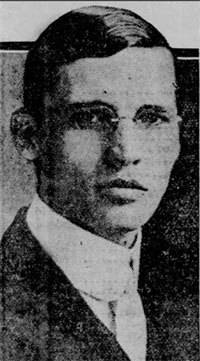
T. Roland Philips 1918 Baltimore Sun.Rev. William Colin Lee (1895 - 1986)
The Rev. William Colin Lee was the rector of the Church of the Redeemer from 1919 to 1922 (?).
The Rev. William Colin Lee was the newly elected rector of the Church of the Redeemer in November 1919. Services were at 11 A. M. and 8 P. M. - Sunday School 9:30 A. M.
In June 1920 the Rev. Wm Colin Lee, rector of the the Reformed Episcopal Church of the Redeemer on Bolton street near Lanvale, was offering open air services in front ot the church from 7 to 7:30 P. M. with "bright singing, special music and a short address by the rector. Everyone cordially invited."
The 1920 census listed William Lee, lodger, age 27, minister church, single, born Ireland, with the family of John Donovan at 1402 Linden street, Baltimore
In May 1921 the Rev. Colin Lee of the Church of the Redeemer presided over the funeral services of Ira Day Miller.
In 1924 William Colin Lee, born Belfast Ireland, 18 October 1895, clergyman, made a declaration of intention to become a US citizen in Pennsylvania. He stated that he had immigrated from Liverpool on the St Paul to New York on August 9, 1915.
William Colin Lee made several trips back to Ireland including in 1920 when he returned on 17 Sep 1920 from Southampton, England to New York, on the Aquitania - destination Philadelphia.
He died in Williamsburg, Va., age 90, in October 1986. He was a graduate of Queens University, Belfast, the University of London and Princeton Theological Seminary. He was survived by a wife, Helen, two daughters and a son, plus 7 grandchildren.
Brown Memorial Presbyterian Church in Park Avenue bought The Church of the Redeemer at Bolton Street near Lanvale in May 1923
1923: In May 1923 Brown Memorial Presbyterian Church paid $24,000 to purchase the Church of the Redeemer on Bolton near Lanvale. The plan was to use the space for religious education and recreation. "Some slight changes will be made in the interior of the Reformed Church building."The church of the Redeemer had not been holding services in the building since June of the previous year. They had united with the Emanuel Reformed Episcopal at Hoffman and Eden streets. The combined congregations planned on building a new church on a new site.
(The Baltimore Sun, May 22, 1923)
Associate Congregational Church - Bolton Street near Lanvale - 1934 to mid 1940s
The Associate Congregational Church was formed in 1900 when the Associate Reformed Congregation united with the First Congregational Church.
The Associate Congregation Church moved to the church at the 1300 block of Bolton in 1934.
1934: June the Rev. Jacob Henry Ehlers was the minister of the Associate Congregational church in the 1300 block of Bolton st.1934: On October 13 the Rev. Bartlett B. James D. D. was giving a Tea and Service at 6:00 P.M.
1934: The Rev. Frank J Landolt, formerly of New Hartford, Conn. was called to the pastorate of the Associate Congregational Church in the 1300 block of Bolton street in November 1934. He gave his first sermon as the new pastor on November 12. He had given a guest sermon in September.
1935: The Baltimore Sun, November 30 The Rev. Dr. Bartlett B. James, teacher of a Bible class at the First Congregational Church in Washington, assumed the position of minister-in-charge of the Associate Congregational Church on Bolton street for the reminder of the year 1935.
1935: The Associate Congregational Church was located in the 1300 block of Bolton in November 1935.
1938: 10 November - an oyster and ham supper was served by the women of the Associate Congregational Church at 1311 Bolton street from 5 to 7:30.
1939: The Baltimore Sun, 18 November 1939 The Associate Congregational Church was planning to hold a rally service at 11 A. M. at the church 1311 Bolton Street. "Former members of the church who have formed no religious connections elsewhere have been invited." The Rev. Dr. Warren B. Dunham minister.
1940: Associate Congregational Church 1311 Bolton Street, Warren B. Dunham, minister 11 A. M."Shifting the Emphasis" Baltimore Sun, May 31
1940: Associate Congregational Church 1311 Bolton Street, Warren B. Dunham, minister 11 A. M."Abundant Life" Baltimore Sun Dec. 14
1940: Dogwood rd, Baltimore Warren B Dunham 77 Head, minister, Congregational, Margene Dunham 54 Wife, Elizabeth Dunham 69 Sister, teacher, elementary school,
1941 July 5, 1941 Congregational - Associate Congregational Church 1311 Bolton street, Warren B Dunham, Minister - Closed. We open September 7
1941: Warren Benyew Dunham Birth 4 Feb 1863 Death 2 Sep 1941 Cemetery: Friends Cemetery Baltimore, Baltimore City, Spouse: Martha Dunham
1941: September - The Rev. Warren B. Dunham, age 78, pastor of the Associated Congregational Church at 1311 Bolton street died after a three month illness.
1941: Associate Congregational Church 1311 Bolton Street, 11 A. M."Problems of Suffering" Rev. Carey Young - 6:30 P. M. Tea and Discussion October 25
1942: Congregational Associate Congregational Church 1311 Bolton street, Rev. Carey Young 6:30 Tea and Discussion The Baltimore Sun, 04 April 1942
1942: Associate Congregational Church 1311 Bolton Street, Rev. George F. Harvey November 7, 1942
1942: November - The Service Men's Center in the Associated Congregational Church, 1311 Bolton street was providing sleeping facilities and Sunday morning breakfast for fifty service men each week. The center was operated by the Congregational Church, the Brown Memorail Presbyterian Church and Memorial Episcopal Church as a cooperative enterprise. The Memorial Episcopal church held a bazaar on December 3rd and 4th to help defray incidental costs (such as 600 bars of soap). When it opened in May of 1942 there were 25 beds in the church. Up to fifty could be provided in necessary.
Maryland in World War II (1939-1945 Maryland Historical Society, 1958)
"Servicemen's Center Three churches - Associate Congregational, Brown Memorial (Presbyterian) and Memorial (Episcopal) jointly sponsored Saturday night facilities for servicemen in the Associate Congressional assembly room 1311 Bolton st. Actually the church needed the space, but yielded in the interest of the need to shelter weekend visitors from nearby camps. The members of the Associate Congregational Church kept the building heated and supplied with hot water, while members of the two congregations alternated in supplying provisions and food."1943: The Baltimore Sun - 02 January - Associated Congregational Church 1311 Bolton street Sermon at 11:00 by the Rev. George F Harvey pastor "A Cordial Welcome to All"1945: April 13 - The Week-End Calendar for Service Men: "Associated Congregational Church 1313 Bolton street - Free lodging Saturday night - Breakfast Sunday morning."
The Bolton Street Center - 1311, 1313, 13117 Bolton Street - 1947 to 1986
1947: May - A bridge party was hosted by the junior women's association of Brown Memorial Church to benefit the Bolton Street Recreational Center which had recently been bought by the church.1948: Space at a former church at 1313 Bolton street was used for inter school after hours games. (Baltimore Bulletin of Education)
1949: October - Rev. Harry W. Foote, assistant pastor at Brown Memorial Church since 1946, resigned to become co-pastor at First Presbyterian Church 5th ave. at 12th street in New York City. In addition to his other duties Rev. Foote had directed the recreational projects of the parish in the Bolton Street Center.
1947-1955: April 1950 - A Cerebral Palsy Nursery School had been in existence for three years in the rear part of a former Episcopal Church building at 1313 Bolton street. In 1950 16 to 33 children were enrolled in speech therapy at the facility. In June 1951 the school had 21 children ranging in age for one and a half years to 5 years. In October 1951 a tuition scholarship was established for children attending the school. Daily out-patient physical, occupational and speech treatment for children and adults with cerebral palsy was offered at the center at 1313 Bolton starting in February 1953. The school was said to be located "in an old church hall in the rear of 1313 Bolton Street." The building was also described as "antiquated". The Baltimore Bowmen held a fund raiser for the Cerebral Palsy School, 1313 Bolton street in May 1955.
1950: A recreational center for boys sponsored by the men's association of the Brown Memorial Church was opened in October at 1313 Bolton Street. It included sports programs and recreational activities conducted by neighborhood agencies, schools and the Boy Scouts.
1951: May 18 the Neighborhood Relief Association of Mount Royal held its annual card party at the Bolton Street Recreation Center at 1313 Bolton at 1:30 P. M.
1952 -53: In 1952-53 basketball was being played at the Bolton Street Community Center.
In October 1953 there were three teams that practiced at the Bolton Street Cnter.
1953: Joseph Reynolds was the director of the Bolton Street Recreational Center.
1953: November 20 - The Brown Memorail held a church bazaar in the evening at the Bolton Street Center 1317 Bolton street. Objects to be auctioned were on view at the Center during the day. Items included rugs, wall hangings, ancient brass tiebacks, rare china, a pair of lovely old Japanese vases with butterfly and dragons, a large Meissen china meat dish, a Benares brass bowl, a wooden jewel box made in France, an old spool type rocker, a Chinese carved table, green milk glass, early blue Willow ironstone china, old silver spoons, a bonnet trunk covered with buffalo hide, and an assortment of other antiques. In addition, there was a "Chimney Corner booth" selling Christmas stocking stuffers.
1954: January - Boys dropped around the gym at the Bolton Street Center for ping pong, wrestling, and other sports.
1954: In March a meeting of a proposed 14-16 year old baseball team was held at the Bolton Street Center.
1954: A postwar revival of the traditional Bolton Street May Fair, sponsored by the Men's Club of Memorial Episcopal church, was held on May 8th on Bolton street between Lafayette and Lanvale. A baseball throw, a water pistol range, a sponge throw and a Normandy kitchen were among the featured games. In the evening there was a dance from 8 till midnight in the Bolton Street Center.
1954: May 2, Softball players, ages 11 to 13, from the Bolton Street Center competed with other teams around the city in a tournament sponsored by fraternities at Johns Hopkins University.
1954: June - The problems of teen-aged youth in the Mount Royal area of the city were discussed at a meeting at Bolton Street Center at 1317 Bolton street on June 15, 1954. There were two recreational centers in Mount Royal at the time: Bolton Street Center and Mount Royal Center.
1954: A square dance with a Halloween theme was given by the Neighborhood Relief Association on Saturday Night at the Bolton Street Center.
1954: Brown Memorial Church held a church bazaar November 19 at the Bolton Street Center, 1300 block of Bolton street. Luncheon was served from 11:30 to 2 P. M. There were two sittings for the turkey dinner - 5:30 and 6:30. A special feature was an antique auction at 8 P. M. Attendees were tempted by gift sales, gift wrapping, a book nook, cakes and a sweet shop, snack bar, white elephant table, country store, candles, plants and "the chimney corner". For children there were games, movies, a puppet show, and a special sandwich supper. Baby sitting was available.
1954: December The Bolton Street Center's windows were "ornamented with simulated candles fashioned of greens and red plastic ribbon."
1955: May 7, A Benefit Auction for the benefit of Memorial Episcopal Church was held at the Bolton Street Center, 1317 Bolton street. For auction by Sam W. Paterson & Co. auctioneers, were: Dresden candy dish, assorted glass and china, brass andirons, brass fender, brass fire tools, drop leaf table, chairs, rugs, mirrors, occasional tables, lamps, bedspreads, silver, ivory necklace, Chineses shawls, prints, Mandarin coat and many other items donated by the friends of the Memorial Episcopal Church.
1955: November 4 - A Thanksgiving theme was used at the fall festival of the Brown Memorial Church held in the Bolton Street Center. The doors opened at eleven o'clock. A wide variety of hand-made items were on sale including sequenced and appliqued Christmas tree skirts, large white Christmas candles, frosted and brused with gold, decorative medallions, and hand dressed dolls.
1956: April 25, The Bolton Hill House Tour started at 10 A. M. and ended at 6 P. M. Luncheon was served at the Bolton Street Center, the 1300 block of Bolton, from noon to 2 o'clock.
1956: May 4 - Knobby, the clown, entertained the children at the annual Boton Street Fair. The event was hosted by the men of Memorial Episcopal Church and featured pony, airplane and hay rides, a Punch and Judy show, refreshments, games, a roving artist for the kids, as well as a bake sale and an antique sale for the adults.
The Evening Sun, May 4, 1956 Knobby the clown and young admirers on the steps of the Bolton Street Center, 1300 block of Bolton.1956: The Bolton Street Recreation Center was widely recognized for its work among children and young people of the "downtown area".
1959: Rev. Robert G. Larimer was involved in the work of the Bolton Street Center of Brown Memorial Presbyterian Church.
1959: August - Teen-aged members, male and female, of the Bolton Recreation Center located at 1317 Bolton street organized a neighborhood clean-up campaign. More than 100 people, of all ages, who lived in the block bounded by Bolton street, Mosher street, Linden avenue and Lafayette avenue spent two hours in the clean-up of an ally. The purpose was a "frontal assault on litter and rat infestation." The center was sponsored by both Brown Memorial and Memorial Episcopal Church.
1959: November - The Great Books group met at the Bolton Community center in late November.
1960: The Bolton Street Center -
"a small recreation building with several rooms and a small gymnasium - was supported by Memorial Episcopal Church and Brown Memorial Presbyterian Church. Contributions were solicited to pay for sending underprivileged children from the center for short stays at a summer camp."1961: October, The work of the Bolton Street Recreation Center, conducted by Brown Memorial and Memorial Episcopal, was to provide extensive programs of education and recreation for children who have come into the neighborhood with their parents from West Virginia and the South.(The Human Side of Urban Renewal" by Martin Millspaugh and Vivian Gurney Breckenfeld, 1960)
1962: December 16 - A Christmas Tree and Greens Sale hosted by the Village Garden Club was held at the Bolton Street Center. Trees of all sizes, holly, evergreens, plain and decorated wreaths, decorated swags and wide red ribbon were offered for sale. Proceeds were contributed to the John Street Park.
1965: A Flea Market was held at the Bolton Street Community Center at 1317 Bolton street on December 4th, 1965 from 10 A. M. to 5 P. M. It was sponsored by the Bolton Hill Supper Club of Brown Memorial Church to fill Christmas baskets for the poor. Real antique merchants, art students and local residents had booths with items for sale. Spaces were rented for $2.00, admission was 25 cents for adults, children were admitted free. Profits for the Supper Club were also made from baked goods and coffee sales. Sellers kept any profit they made.
1967: November 7, 1317 Bolton street was a polling place in the Third Precinct, 11th Ward.
1968: April 5 Classical Dance of India was presented in the Maryland Institute's coffee house at 1317 Bolton street at 8 P. M.
1968: April 26, The Fine Arts Theater of the Maryland Institute presented Arthur Kopit's one-act satire on contemporary social customs, "The Day the Whores Came Out to Play Tennis", on Friday evening at 10 P. M. in the institute's coffee house (called the Underground) in the Brown Memorial church at 1317 Bolton street. The event was free to the public.
1968: May 14, 3rd Precinct 11th Ward polling at 1317 Bolton street.
1969: January 4 - Folk dancing at the Bolton Hill Recreation Center, "1321" Bolton street from 8 to 11 (lessons from 8 to 9:30).
1969: May 9th, A series of original pieces written by Maryland Institute students was presented at the Underground Coffeehouse, Bolton Hill Recreation Center 1317 Bolton street at 10 P.M.
1969: October 4, An interfaith, interracial, flea market at the Bolton Community center 1300 block Bolton street benefited Meals-On-Wheels. The event was hosted by the volunteers of the Presbyterian Meals-on-Wheels project. More than 30 tables offered antiques, white elephant, records, rugs, jewelry, art, crafts, hand made dolls, dried flowers, pottery, books, plastic dinner ware, Christmas gifts, and homemade food. The downtown Brown Memorial Day Nursery had a game table for children and offered hot dogs and soft drinks from the center's stage. The Bolton Hill Bullets basketball team did the set up and clean up and also held a bake sale. Ten chuches participated. Proceeds from the table rentals (10 dollars) and admissions (twenty-five cents) went to Meals-on-Wheels. Proceeds from the individual tables went to a variety of charitable causes.
1969: December 13 - Flea Market at Bolton Community Center, 1300 N Bolton. Charity, Santa, Xmas Gifts, White Elephant. League Ch. A. M. C. D.
1972: October 7 - Festival on the Hill sponsored by Memorial Episcopal church was to be held in the 1300 block of Bolton street from 11 A. M. to 3 P. M. Bull-roast, beer garden, hot dogs, raw bar, soft drinks, fun and games, country store, cakes, candy, gourmet foods, juniquities, plants, floweres, and a fancy table were offered. In case of rain the bazaar was to be held in the Bolton Street Center.
1973: Brown Memorial supervised a recreational program for teen-agers at the Bolton Community Center, "a onetime church in the 1300 block of Bolton."
1981: The Baltimore Dance Studio moved into 1317 Bolton street in January 1981. Co-founded by Shelley Walpert-Fineman the aim was to provide a non competitive space for local dancers and choreographers. The building was rented from Brown Memorial Church. The studio was the recipient of a $12,000 National Endowment for the Arts grant.
The Theater Project had closed in the summer of 1980 leaving dancers with no place to practise for a reasonable price. Shelley Walpert-Fineman began looking for a venue that could serve as a studio as well as a performance space for her 200 students. She found it in the old church with a wooden floor where local Bolton Hill residence had been playing basketball.
Programs were offered in different dance styles in January, April, June and July.
1983 - 1311 Bolton Street FOR SALE
1983: June 19, BOLTON HILL. 1311 BOLTON STREET. NEW LISTING. Bolton Street center. Once in a lifetime opportunity to buy a church building (last used as a community center) LOT 60X1501983: July 27 BOLTON HILL 1311 BOLTON STREET - Sturdy granite church building, slate roof. Best use: single family or condo. $100,000.
Bolton Street Synagogue - 1311 Bolton Street - 1986 to 2003
1986: Rabbi Earl A. Jordan was the founder of the Bolton Street Synagogue in 1986. Rabbi Jordan's idea for the congregation were non conformist. The congregation was not affiliated with any of the major branches of Judaism: Orthodox, Conservative, Reform or Reconstructionist. A conservative prayer book was used, non Jewish spouses of Jewish members were admitted to membership, and women were allowed to play a larger role during worship.The home of the new congregation was
"an old Gothic-style, gray stone chapel at 1307* Bolton St. owned but not used for years by Brown Memorial Church, is to be restored and renovated as the permanent home of the synagogue."for the high holydays when the congregation's attendance was expected to be too large for the small church, services were to be held at the Prince Hall Grand Lodge of Masons at Eutaw Place and Lanvale streets, formerly Temple Oheb Shalom. The congregation had 40 members.(Baltimore Sun, 06 June 1986)
*This is clearly an error.
The Rev. David Malone and Rabbi Earl A. Jordan standing before Brown Memorial's unused chapel, due to become new synagogue. Baltimore Sun, July 06, 1986
1989:
"In January 1989, announcement was made of the acquisition of the old Brown Memorial Church Chapel, 1311 Bolton Street, for the permanent home of the Bolton Street Synagogue. It was occupied on January 29, 1989."1989: Some of the widows were still boarded up, the heating system still did not work, and the floor was still marked with lines from the basketball court, but the new synagogue held a brief dedication ceremony in the building at 1311 Bolton on January 29, 1989. Plans were for the regular use of the building in the spring. Brown Memorial sold the building to the synagogue group for $100,000. About $40,000 was spent on renovations.(Synagogues, Temples, and Congregations of Maryland: 1830-1990, Earl Pruce, Jewish Historical Society of Maryland, 1993)
Baltimore Sun, January 30, 1989
1996: Baltimore Sun, 16 & 29 Aug - Rabbi Mona Decker and Canto Alan Rubinstein of The Bolton Street Synagogue advertised an introductory offer to become a member of the shul at 1311 Bolton for Rosh Hashanah and Yon Kipppur 5757
The synagogue move to Cold Springs Lane in Roland Park in 2003, maintaining the name Bolton Street Synagogue.
The synagogue took the stained glass window from the front of 1311 Bolton to the new building on Cold Spring Lane.
Bolton Street Synagogue web site
1311 Bolton 2003 to Present
2004: April - Hill & Co. listed the church:
Bolton Hill New listing 1311 Bolton St. - Handsome stone structure designed in 1870 by respected Baltimore architect Charles Cassel."Bring your imagination and create a unique living space. Lg lot with room for garden and parking"
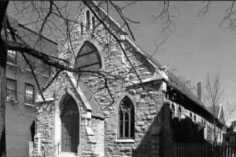
Hill & Co. ad, April 2004
The building had been listed at $529,000 but did not sell so it was put up for auction by A. J. Billig & Co., auctioneers. The seller was 1311 Bolton LLC, a company that bought the building from the synagogue.
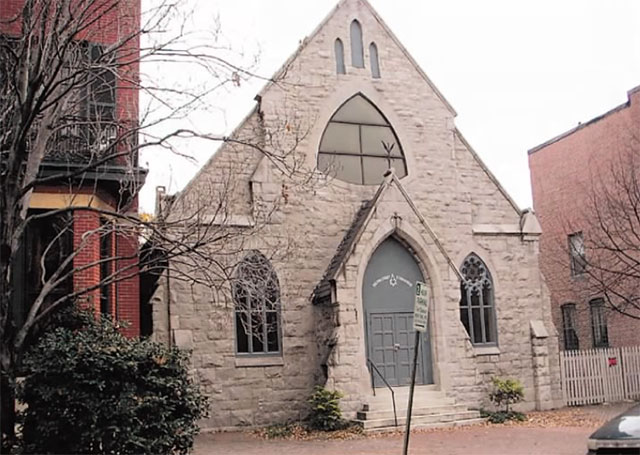
Baltimore Sun, 2005
2005: January 14 Real Estate Auction Sale on Premises 1311 Bolton Street off 230 W. Lanvale, Baltimore, Friday January 14 2005 at 2:00 P. M.
"Impressive Stone Building circa 1870, was formerly occupied by the Reformed Episcopal Church, Brown Memorial Presbyterain Church and Bolton Street Synagogue."Further info: 60' by 150'4.5" to Jenkins Alley. Building located towards the fornt of the site. Potential parking in the rear. site is level and clear.
"Stone church building, approximately 40' x 80', with gabled slate roof, marble steps, arched windows, wood fence and brick sidewalk. The building is constructed on a full basement foundation with interior and exterior entrances. The first floor contains an open sanctuary with wood beamed ceiling, raised pulpit and rear room. Basement contains rest room, offices and storage. Gas forced hot air heat and central air conditioning on first floor.
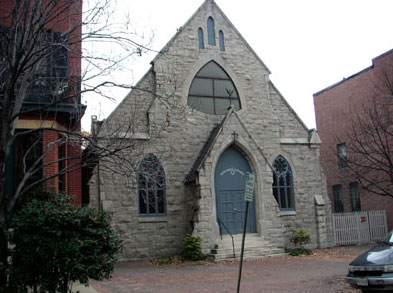
Auction notice 2005
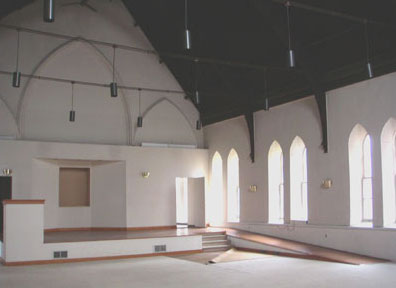
Auction notice 2005 - interior
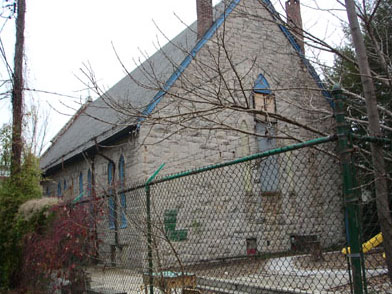
Auction notice 2005 - rear
The building was bought by Travis Hardaway and Roberta Faux in August 2005. They converted it into a single family dwelling. The renovation was designed by Richard Hardaway. Construction started early in 2006 and the family moved into the building in August 2007.
